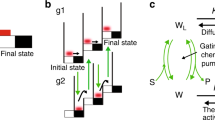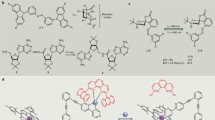Abstract
We discuss the possibility of implementing a switch based on a conformational change, consisting in a relative rotation of a molecule containing two benzene rings, functionalized with proper substituents. Contacts are simulated with three-atom gold clusters, which are connected to the rest of the molecule via a thiol group. Relative rotation of the two rings, induced by a transverse electric field, determines a variation of the height of the potential barrier separating them, due to the change in the amount of conjugation of the π orbitals. The action of such a barrier is evaluated by computing the shift of the electron density as a function of a longitudinal electric field.
Similar content being viewed by others
References
P. Damle, T. Rakshit, M. Paulsson, and S. Datta, “Current-voltage characteristics of molecular conductors: two versus three terminal,” IEEE Trans. on Nanotechnology, 1, 145 (2002).
A.W. Ghosh, T. Rakshit, and S. Datta, “Gating of a molecular transistor: Electrostatic and conformational,” Nanoletters, 4, 565 (2004).
J.P. Launay and C. Coudret, “Chemical approaches of molecular switches,” Ann. N.Y. Acad. Sci., 852, 116 (1998).
J.M. Seminario, A.G. Zacarias, and J.M. Tour, “Theoretical study of a molecular resonant tunneling diode,” J. Am. Chem. Soc., 122, 3015 (2000).
C.W. Bauschlicher Jr. and A. Ricca, “Conductivity at low temperatures, are the rings eclipsed or perpendicular?,” Chem. Phys. Lett., 369, 415 (1998).
M. Girlanda, I. Cacelli, A. Ferretti, and M. Macucci, “Conductance modulation in molecular devices via field-induced conformational change,” to be published in IEEE Transactions on Nanotechnology.
I. Cacelli, A. Ferretti, M. Girlanda, and M. Macucci, “Theoretical study of molecular switches based on electrically induced conformational changes,” to be published.
S. Franzen, “Density functional calculation of a potential energy surface for alkane thiols on Au(1 1 1) as function of alkane chain length,” Chem. Phys. Lett., 381, 315 (2003).
A. Ricca and C.W. Bauschlicher Jr., “Interaction of a conjugated phenylene ethynylene trimer with a Au(1 1 1) surface,” Chem. Phys. Lett., 372, 873 (2003).
Y. Karzazi, X. Crispin, O. Kwon, J.L. Brédas, and J.L. Cornil, “Influence of contact geometry and molecular derivatization on the interfacial interactions between gold and conjugated wires,” Chem. Phys. Lett., 387, 502 (2004).
M. Girlanda and M. Macucci, “Theoretical analysis and numerical simulation of intramolecular barriers in polyphenyl-based molecular devices,” J. Phys. Chem. A, 107, 706 (2003).
A.D. Becke, “Density-functional thermochemistry. III. The role of exact exchange,” J. Chem. Phys., 98, 5648 (1993).
Author information
Authors and Affiliations
Corresponding author
Rights and permissions
About this article
Cite this article
Girlanda, M., Cacelli, I., Ferretti, A. et al. Numerical Investigation of a Molecular Switch Based on Conformational Change, with the Inclusion of Contacts. J Comput Electron 4, 87–90 (2005). https://doi.org/10.1007/s10825-005-7114-9
Issue Date:
DOI: https://doi.org/10.1007/s10825-005-7114-9




